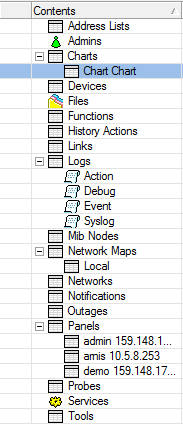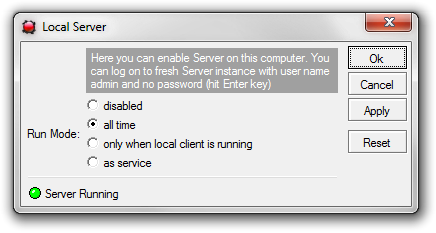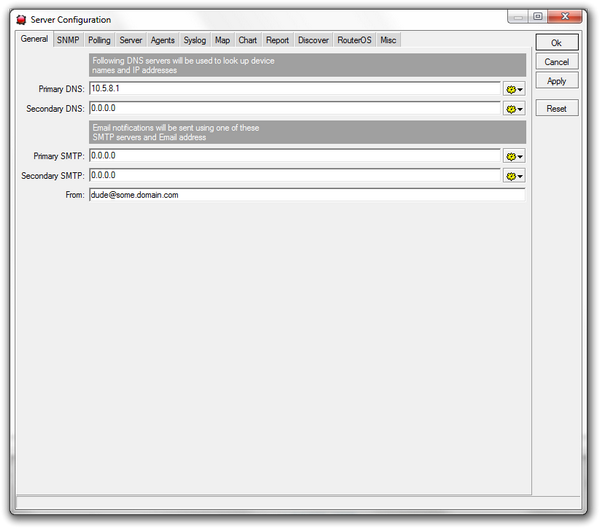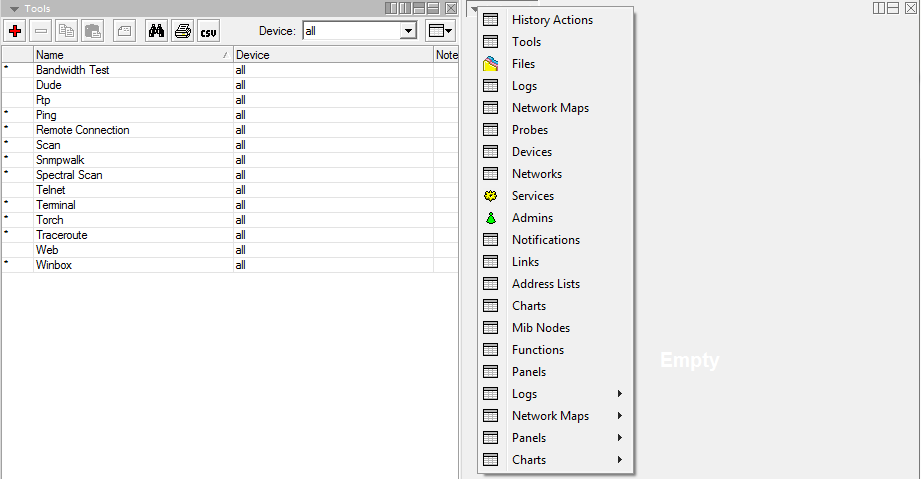Manual:The Dude/Interface
Server settings
The server settings panel is located in the top-left corner of the Dude interface. It contains the following buttons:
- Connect/Disconnect - Connects to a Dude server (including Localhost) or disconnects from it
- Preferences - general Dude preferences
- Local server - local server settings
- Help - link to this webpage
- Undo/Redo - allows to undo or redo the last action
- Settings' - settings of the currently connected server
- Export/Import - allows to save, or load Dude configuration files
Preferences
- Auto connect at startup self explanatory
- Auto reconnect if connection is lost - self explanatory
- Appear only inside tray when minimised - do not show Dude in Windows task bar
- Hide tray icon (deselected by default) - hide Dude from tray
- Status Bar - Show bottom status bar
- Language - can change language of The Dude interface
Local server
Local server is the instance on your Windows PC which is used by default when opening the Dude program. It connects to Localhost. If you plan to scan and manage devices from another machine, and only use the Dude application to connect to a remote host, you can disable the local server.
- Disabled - Local server is disabled at all times
- All time - Local server is enabled always
- Only when local client is running - self explanatory
- As service - run the Dude local server as a windows service
Server settings
Allows configuration of various aspects of the currently connected server. More specific explanation of all the options in the The Dude/Server Settings article.
Panes
The main Dude window is split into sections, called Panes. When first opening The Dude you will see the main Window frame with Server setting buttons, the Tools pane and the Map pane. The Map pane can be either split into parts, or replaced by any other pane.
The simplest way to open another pane instead of the map, is to click one of the items in the Tools pane. It is also possible to use the Dropdown menu in each panes top left corner.
Tool pane

- Address lists - Lists of IP addresses to be used in Blocklist and other places
- Admins - Users who can access this particular Dude server
- Charts - Configure graphs based on any data source in the map
- Devices - List of all the devices drawn on any of the network maps
- Files - List of the files uploaded to the server, like images for network map backgrounds and sounds
- Functions - Functions that can be used, includes scripts and advanced queries
- History Actions - History of tasks performed by the admin, like adding or removing devices. Admin log.
- Links - List of all links in all maps.
- Logs - Logs of device statuses. Dude also includes a Syslog server, and can receive Logs from other devices.
- MIB nodes - Information about MIBs
- Network maps - All maps
- Networks - List of all network segments places on the map
- Notifications - Different ways to alert the admin of
- Panels - Allows to configure separate dude window entities for use on multiple monitors or otherwise
- Probes - Probes are responsible for polling specific services on the defices
- Services - Lists the currently monitored services on all devices
- Tools - Configures the tools that can be run on each device (ie. connect with winbox, telnet, ftp etc.)
Map window
The main part of the Dude window is occupied by the device map (at least upon first startup, later you can customize that). The map shows graphical layout of your network. If you used device discovery earlier, it will already be populated by devices in your network, but it is also possible to add devices one by one, by using the Add button.
The map contains two layers, device links, and device dependencies. To avoid receiving reports about each device status when a parent device is unreachable, you can configure which device is dependent on which other device.





